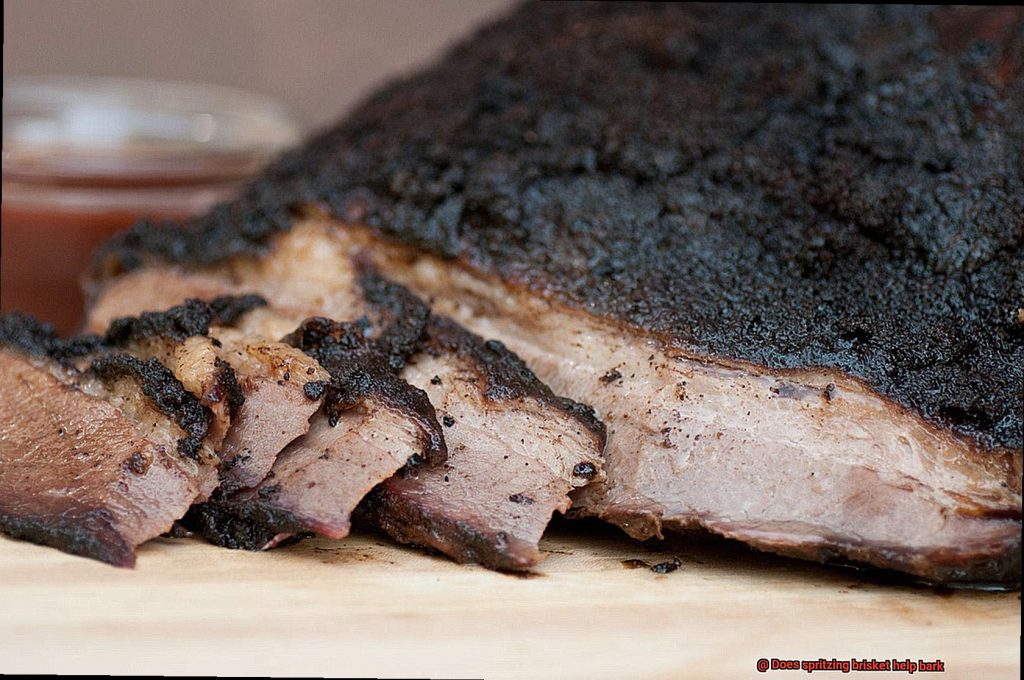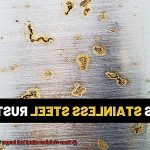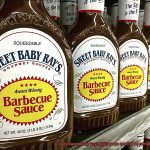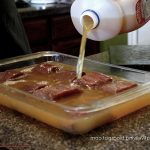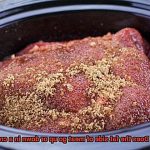Hey there, meat lovers. Are you a fan of slow-cooked brisket with a crispy bark that’s packed with flavor? If so, you may have heard that spritzing your brisket can help enhance the bark. But is it just another barbecue myth or is there some truth to this popular technique? In this blog post, we’ll delve into the science behind how spritzing affects the formation of bark on your brisket.
First things first, let’s talk about what we mean by “bark.” The bark is that deliciously caramelized crust that forms on the outside of the brisket during cooking. It’s what makes each bite of brisket so mouthwateringly irresistible and gives it that signature smoky flavor.
Now, let’s get back to spritzing. The idea behind spritzing is to moisten the surface of the brisket with a liquid – usually apple juice, water, or vinegar. Proponents of spritzing claim it helps create a better bark by keeping the surface moist and preventing it from becoming too dry or tough.
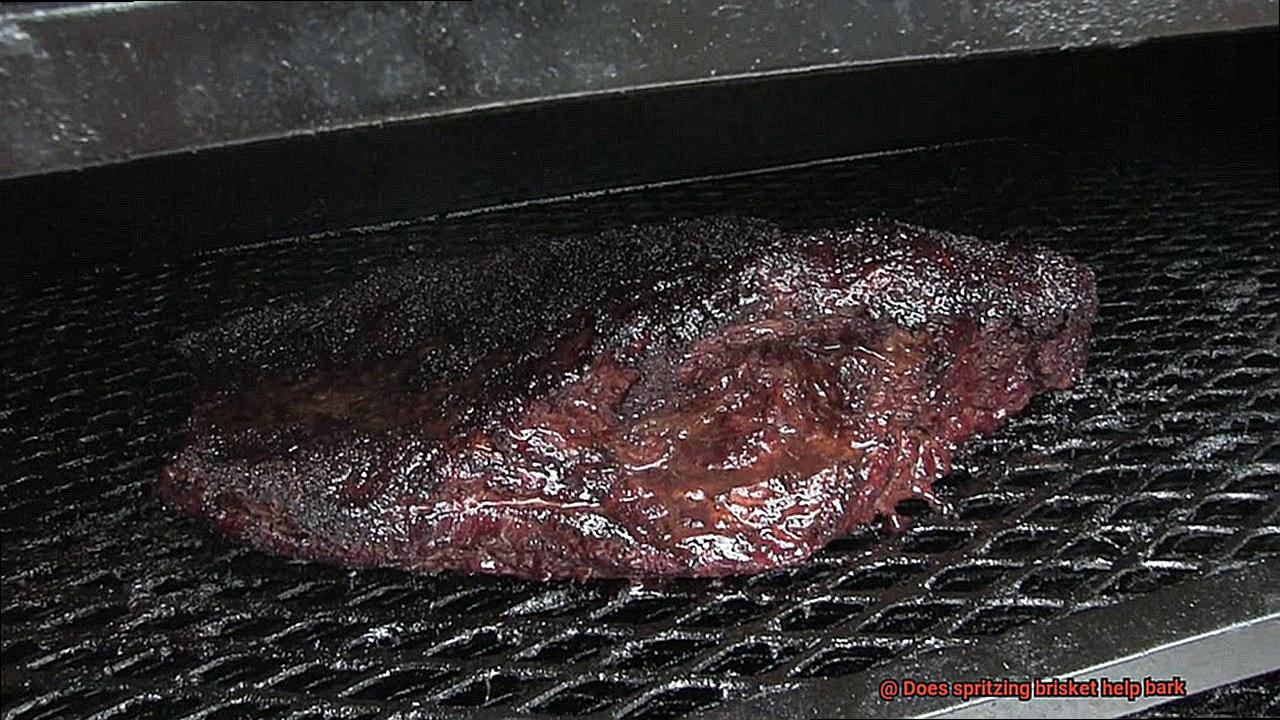
But does it actually work? Some experts swear by it while others remain skeptical. That’s why we’re going to explore the science behind how spritzing affects the cooking process and chemical reactions that occur on the surface of your brisket. We’ll cover all bases so whether you’re a seasoned pitmaster or new to barbecuing, you’ll learn everything you need to know about spritzing and how it affects your brisket’s bark.
So join us as we uncover whether spritzing really helps create a better bark on your beloved brisket. Trust us; your taste buds will thank you for it.
Contents
What is Spritzing?
One such technique that is gaining popularity is spritzing. So, what exactly is spritzing and how does it affect the meat you’re cooking?
Spritzing is the act of spraying a liquid mixture onto your meat while it’s cooking. The liquid mixture can vary, but often includes a combination of water, vinegar, fruit juice, or other liquids that add flavor and moisture to your meat. This technique helps to prevent the meat from drying out during the cooking process and creates a delicious, juicy result.
You can use a spray bottle or a mop-style brush to apply the liquid mixture every 30 minutes to an hour depending on your recipe and preferences. However, some pitmasters argue that constantly opening the smoker or grill to spritz the meat can cause temperature fluctuations, which can disrupt the cooking process.
When it comes to creating a delicious bark on the outside of your meat, spritzing can be both helpful and controversial. Some pitmasters believe that spritzing helps create an even bark that adds texture and flavor to every bite. Others argue that spritzing dilutes the flavor of your rub or seasoning and leads to a less intense bark.
Regardless of these debates, it’s essential to experiment with different techniques and ingredients to find what works best for you. Here are some tips to keep in mind when using spritzing in your barbecue:
- Use a liquid mixture that complements your rub or seasoning.
- Don’t overdo it – too much spritzing can cause your bark to become soggy.
- Consider using a mop-style brush instead of a spray bottle to avoid disrupting the cooking process.
- Experiment with different spritzing frequencies to see what works best for your recipe.
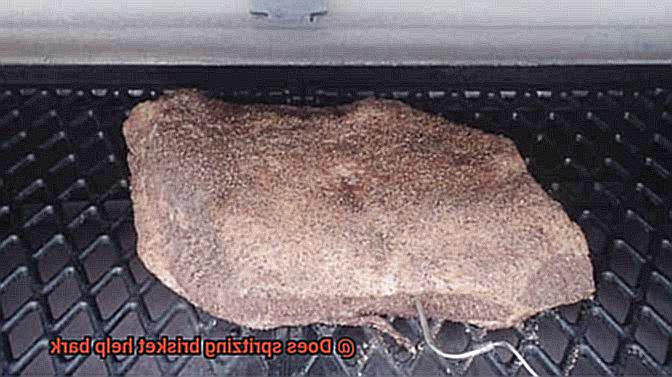
The Benefits of Spritzing Brisket
Look no further than spritzing. As an expert on the topic, I can attest that spritzing is a simple yet effective technique that can take your brisket to the next level.
Spritzing involves spraying a liquid of your choice, such as water, apple juice, beer, or vinegar, onto the surface of the meat during the cooking process. The benefits of spritzing are numerous and can enhance every aspect of the brisket.
Firstly, spritzing can help improve the bark on your brisket. The bark is the outer layer of the meat that forms during cooking and gives it a delicious crusty texture and flavor. By spritzing regularly, you can keep the bark moist, prevent it from drying out, and help it develop a deeper color.
In addition to enhancing the bark, spritzing can also regulate the temperature of your brisket. When you spray liquid onto the surface of the meat, it cools down slightly, which can prevent overcooking and drying out. This is particularly useful when cooking with a smoker as it helps regulate the temperature inside the smoker by adding moisture to the air.
Lastly, spritzing adds an extra layer of flavor to your brisket. By using a liquid with a strong taste profile such as apple juice or vinegar, you can infuse your meat with additional complexity and depth. This is especially helpful if you’re using a rub or seasoning that has a more subtle flavor profile.
The Drawbacks of Spritzing Brisket
While it may seem like an essential step in achieving that mouth-watering, delicious meat, it’s important to consider the impact it can have on your end product. Let’s delve into the potential drawbacks of spritzing.
Firstly, spritzing can slow down the formation of bark on your brisket – that coveted crispy, flavorful exterior that everyone craves. By introducing more moisture to the surface of the meat, it can make it difficult for bark to form. If you’re looking to achieve that perfect bark, minimizing or eliminating spritzing may be worth considering.
Another potential drawback is that spritzing can dilute the flavor of your rub. Dry rubs are a crucial component in any good brisket recipe, adding flavor and texture to the meat. However, when you spritz your brisket with liquid, you risk washing away some of that flavor. This can result in a less flavorful end product.
Lastly, spritzing can increase the cook time of your brisket. Every time you open your smoker or grill to spritz your meat, you’re releasing heat and smoke which can extend your cook time. This can be frustrating if you’re trying to achieve a specific level of doneness.
Of course, there are some benefits to spritzing such as adding moisture and preventing your meat from drying out. However, if you’re prioritizing a crispy, flavorful bark on your brisket, it’s worth considering alternative techniques.
Tips for Successful Spritzing
If you want to take your brisket to the next level, spritzing can be a game-changer. However, there are a few things to keep in mind in order to ensure successful spritzing. Here are some tips:
Choose the right spritzing liquid
The liquid you use for spritzing should enhance the flavor of the meat without overpowering it. While apple cider vinegar and water are popular choices, don’t be afraid to experiment with other flavors like beer, fruit juice, or Worcestershire sauce. The key is to find a blend that works for you.
Timing is key
Spritzing should start about two hours into the cooking process and then every 30 minutes thereafter. This allows the liquid to penetrate the meat and create a flavorful bark on the outside. It’s important not to spray too often, as this can cause the bark to become soggy.
Use a fine mist spray bottle
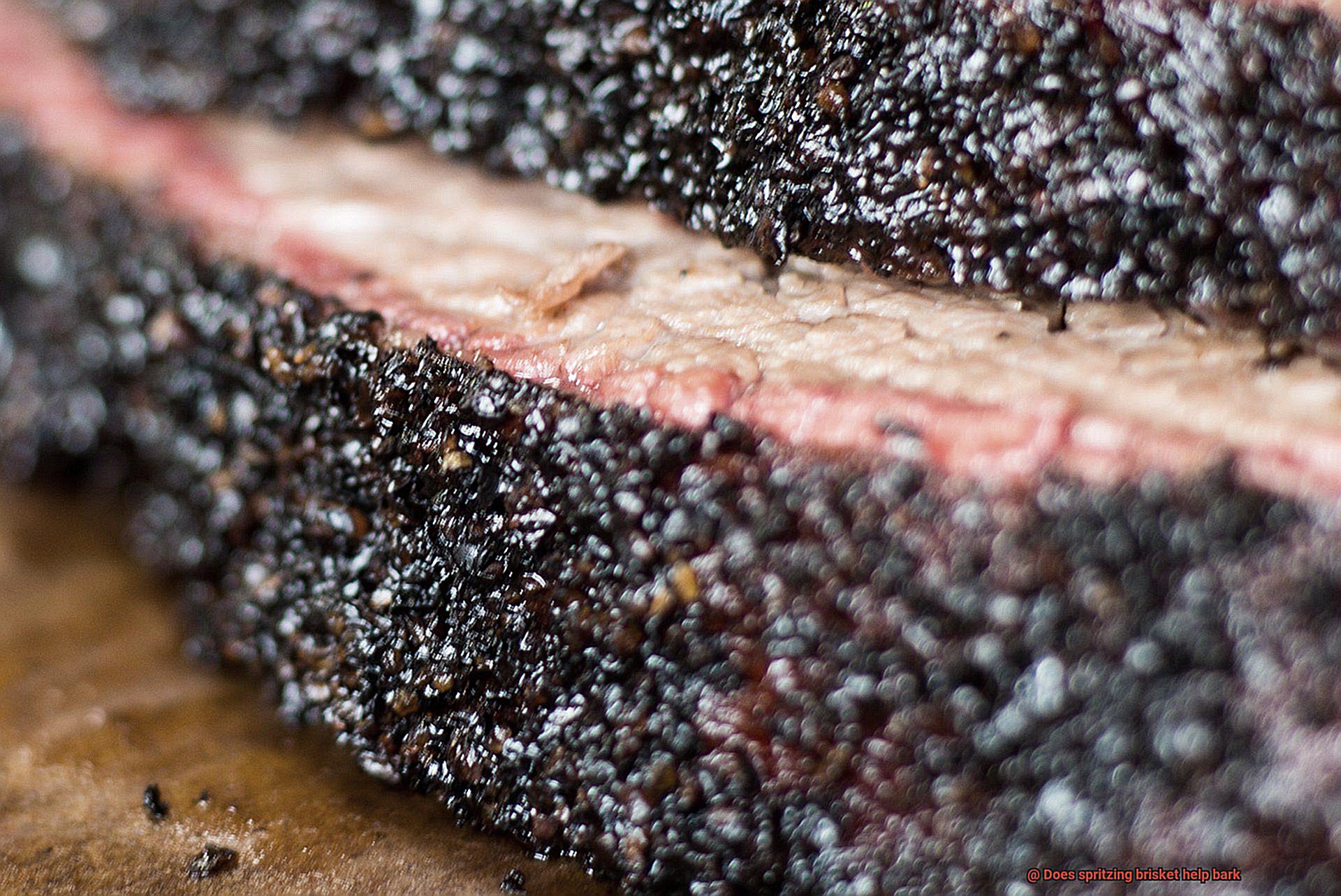
Spraying with a brush or mop can disturb the bark that has already formed on the meat. A fine mist spray bottle allows for even distribution of the liquid without ruining the bark. It’s also important not to oversaturate the meat, as this can wash away some of the seasoning and rub that has been applied.
Monitor temperature
Temperature control is crucial in smoking brisket. If the temperature is too low, you may need to spritz more frequently. If it’s too high, the meat may cook too quickly and not have enough time to develop a good bark. Keep an eye on your smoker or grill and adjust as needed.
Remember spritzing is just one piece of the puzzle
While spritzing can help develop a flavorful bark on your brisket, it’s important to remember that it’s just one factor in creating great BBQ. Pay attention to other factors like rub application, smoke flavor, and cook time to truly elevate your brisket game.
Alternatives to Spritzing
While spritzing is a popular method used by many pitmasters, there are alternatives that can also deliver the same delicious results.
One alternative to spritzing is using a dry rub. Dry rubs are a blend of spices and herbs that are rubbed onto the surface of the meat before cooking. Letting the rub sit for a few hours or overnight allows the flavors to penetrate the meat and create a crusty bark. Brown sugar, paprika, garlic powder, and chili powder are just some of the popular ingredients in dry rubs for brisket.
Another alternative to spritzing is using a mop sauce. Mop sauces are thin liquids that are brushed onto the meat during cooking. They not only add flavor but also keep the meat moist while creating a caramelized bark on the outside. You can make mop sauces with ingredients such as beef broth, apple cider vinegar, Worcestershire sauce, and soy sauce.
If you want to try something different, consider wrapping the brisket in foil or butcher paper during cooking. This method traps in moisture and allows the meat to cook in its own juices, resulting in a tender and flavorful brisket with a crispy crust.
Safety Considerations When Spritzing Brisket
If so, then you’re probably familiar with the technique of spritzing. Spritzing is an excellent way to keep your brisket moist and flavorful while it cooks. However, like any cooking method, there are safety considerations you need to keep in mind.
First and foremost, the safety of your food should always be a top priority. To ensure this, use a food-safe spray bottle that has not been contaminated by other chemicals or substances. Also, make sure that the liquid being spritzed is safe for consumption and free of harmful bacteria.
When handling hot brisket and spritzing it, make sure to wear heat-resistant gloves or mitts. This will protect your hands from burns and ensure that you handle the meat safely. Remember, safety first.
Another important safety consideration is distance. The grill or smoker can be hot, so keep a safe distance when spritzing your brisket to prevent any accidents or injuries. Never lean over the grill or smoker while spritzing, as this can result in burns or even fires.
Lastly, after you’re done with spritzing your brisket, clean your spray bottle thoroughly and dispose of any leftover liquid properly. This will prevent bacterial growth and contamination.
In summary, here are some key safety considerations when spritzing brisket:
- Use a food-safe spray bottle
- Ensure the liquid being spritzed is safe for consumption and free of harmful bacteria
- Wear heat-resistant gloves or mitts when handling hot brisket
- Keep a safe distance from the grill or smoker when spritzing
- Properly dispose of any leftover liquid and clean your spray bottle thoroughly
Common Mistakes to Avoid When Spritzing Brisket
Spritzing your brisket is a great way to keep it moist during the cooking process, but it can also lead to some common mistakes that can affect the highly prized bark. Here are some tips to avoid those common mistakes and achieve a delicious and flavorful bark.
Over-Spritzing
Applying too much liquid too frequently is the first mistake to avoid. Over-spritzing can wash away the rub and prevent the bark from forming properly. It can also make the brisket too wet, leading to steaming instead of smoking, which results in a softer bark.
Wrong Spritzing Liquid
Using the wrong spritzing liquid is another mistake to avoid. Some liquids, such as apple juice or vinegar, can break down the bark and make it mushy. It’s important to use a liquid that complements the flavors in the rub and enhances the bark, such as beef broth or Worcestershire sauce.
Timing
Timing is crucial when spritzing brisket. Spritzing too early in the cooking process before a good bark has formed risks washing away any rub that has been applied and preventing a bark from forming at all. On the other hand, waiting too long to spritz risks drying out the meat and making it tough. Keep an eye on your brisket and time your spritzes accordingly.
Spritzer
Using a spritzer that produces large droplets of liquid is another mistake to avoid. These droplets can wash away rub and prevent a good bark from forming. Instead, use a fine mist sprayer or even just a regular spray bottle to apply a light coating of liquid.
Conclusion
To sum it up, spritzing brisket can be a game-changer when it comes to elevating the bark and flavor of your slow-cooked meat. However, it’s crucial to have a basic understanding of the science behind how spritzing affects the cooking process and chemical reactions that occur on the surface of your brisket.
While some pitmasters swear by spritzing, others remain skeptical and prefer alternative methods such as dry rubs or mop sauces. If you do decide to give spritzing a try, there are a few essential things to keep in mind.
Firstly, choosing the right liquid mixture that complements your rub or seasoning is key. Secondly, timing your spritzes appropriately is crucial for achieving optimal results. Finally, using a fine mist spray bottle will help you avoid disrupting the cooking process.
It’s also important to monitor temperature and consider safety considerations when handling hot brisket and disposing of leftover liquid. To ensure success with this technique, there are common mistakes to avoid such as over-spritzing, using the wrong spritzing liquid, timing incorrectly, and using a spritzer that produces large droplets of liquid.
In conclusion, whether you choose to use spritzing or an alternative method for enhancing the bark on your brisket ultimately comes down to personal preference. The key is experimentation with different techniques and ingredients until you find what works best for you.

